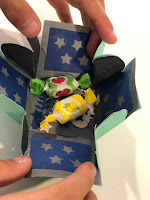Briggs-Rauscher Reaction
Having fun as always in my chemistry lab!!This with 15-17 year olds in a workshop
/demonstration-56a128ab5f9b58b7d0bc9381.jpg)
/demonstration-56a128ab5f9b58b7d0bc9381.jpg)
INTRODUCTION
The Briggs-Rauscher reaction, also known as 'the oscillating clock', is one of the most common demonstrations of a chemical oscillator reaction.
The reaction begins when three colourless solutions are mixed together. The colour of the resulting mixture will oscillate between clear, amber, and deep blue for about 3-5 minutes. The solution ends up as a blue-black mixture.
SOLUTIONS
- Solution A:
Add 43 g potassium iodate (KIO3) to ~800 ml distilled water. Stir in 4.5 ml sulfuric acid (H2SO4). Continue stirring until the potassium iodate is dissolved. Dilute to 1l.
- Solution B:
Add 15.6 g malonic acid (HOOCCH2COOH) and 3.4 g manganese sulfate monohydrate (MnSO4 . H2O) to ~800 ml distilled water. Add 4 g of cornstarch. Stir until dissolved. Dilute to 1l. - Solution C:
Dilute 400 mL of 30% hydrogen peroxide (H2O2) to 1 L.
MATERIALS
- 300 mL of each solution
- 1 L beaker
- stirring plate
- magnetic stir bar
PROCEDURE
- Place the stirring bar into the large beaker.
- Pour 300 ml each of solutions A and B into the beaker.
- Turn on the stirring plate. Adjust the speed to produce a large vortex.
- Add 300 mL of solution C into the beaker. Be sure to add solution C after mixing solutions A + B or else the demonstration will not work. Enjoy!
NOTES
This demonstration evolves iodine. Wear safety goggles and gloves and perform the demonstration in a well-ventilated room, preferably under a ventilation hood. Use care when preparing the solutions, as the chemicals include strong irritants and oxidizing agents.
CLEAN UP
Neutralize the iodine by reducing it to iodide. Add ~10 g sodium thiosulfate to the mixture. Stir until the mixture becomes colorless. The reaction between iodine and thiosulfate is exothermic and the mixture may be hot. Once cool, the neutralized mixture may be washed down the drain with water.
THE BRIGGS-RAUSCHER REACTION
IO3- + 2 H2O2 + CH2(CO2H)2 + H+ --> ICH(CO2H)2 + 2 O2 + 3 H2O
This reaction can be broken into two component reactions:
IO3- + 2 H2O2 + H+ --> HOI + 2 O2 + 2 H2O
This reaction can occur by a radical process which is turned on when I- concentration is low, or by a nonradical process when the I- concentration is high. Both processes reduce iodate to hypoiodous acid. The radical process forms hypoiodous acid at a much faster rate than the nonradical process.
The HOI product of the first component reaction is a reactant in the second component reaction:
HOI + CH2(CO2H)2 --> ICH(CO2H)2 + H2O
This reaction also consists of two component reactions:
I- + HOI + H+ --> I2 + H2O
I2CH2(CO2H)2 --> ICH2(CO2H)2 + H+ + I-
The amber color results from the production of the I2. The I2 forms because of the rapid production of HOI during the radical process. When the radical process is occurring, HOI is created faster than it can be consumed. Some of the HOI is used while excess is reduced by hydrogen peroxide to I-. The increasing I- concentration reaches a point at which the nonradical process takes over. However, the nonradical process does not produce HOI nearly as fast as the radical process, so the amber color begins to clear as I2 is consumed more quickly than it can be created.
Eventually the I- concentration drops low enough for the radical process to restart so the cycle can repeat itself.
The deep blue colour is the result of the I- and I2 binding to the starch present in the solution.

Comments
Post a Comment